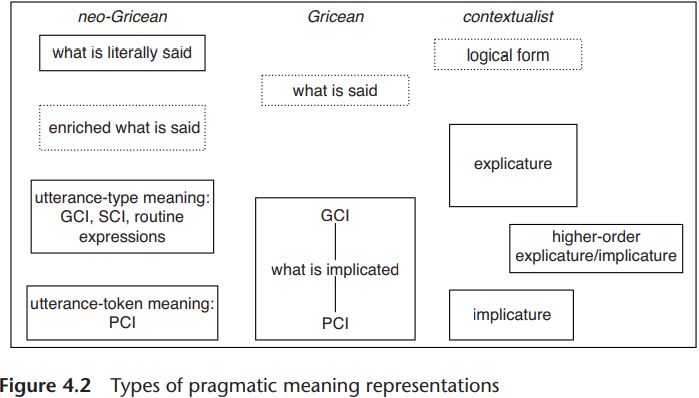
An interim conclusion: on pragmatic meaning representations
 المؤلف:
Jonathan Culpeper and Michael Haugh
المؤلف:
Jonathan Culpeper and Michael Haugh
 المصدر:
Pragmatics and the English Language
المصدر:
Pragmatics and the English Language
 الجزء والصفحة:
114-4
الجزء والصفحة:
114-4
 9-5-2022
9-5-2022
 917
917
An interim conclusion: on pragmatic meaning representations
While Grice started with an initial distinction between what is said and what is implicated, both neo-Gricean and contextualist approaches to pragmatic meaning have proposed more nuanced and layered understandings of meaning representations, as summarized in Figure 4.2.
In Figure 4.2, the different layers of pragmatic meaning are represented vertically within distinct approaches, while the different ways of conceptualizing these different layers are represented horizontally across approaches. Solid lines indicate representations that have been treated as key meaning representations in those approaches, while dotted lines indicate representations that are either the subject of ongoing debate (e.g. Gricean what is said), or are not recognized as meaning representations proper (e.g. logical forms). However, since the various types of meaning representations are theorized in different ways, Figure 4.2 represents only analogous, not equivalent, concepts of pragmatic meaning. But putting terminological and theoretical battles aside for the moment, it is apparent that there have been a number of key developments of Grice’s initial approach to conceptualizing pragmatic or speaker meaning representations.
One key development is that representations of what is said may be approached both at the level of what is literally said and at the level of a pragmatically enriched notion of what is said (i.e. explicature), which mirrors, to some extent at least, the folk distinction between saying1 and saying2. What contextualist approaches have added is a deeper understanding of the different types of representations that such pragmatic enrichments involve. A second key development is the claim that there is an important layer of utterance-type pragmatic meaning that has only received passing attention thus far, including routine expressions and short-circuited implicatures (SCI) (less controversially), and generalized conversational implicatures (GCI),

Including scalar implicatures (more controversially). A third key development is that meaning representations may be further embedded within other meaning representations, a point we take up further.
It is interesting to note that, throughout this discussion, natural language concepts from English have frequently been used to conceptualize and even define pragmatic meaning representations. The question we have already raised in relation to what is said (cf. saying) and what is implicated (cf. implying), and to which we might add the distinction between saying1 and saying2, is whether such distinctions, which can be made in English, are equally as useful for examining pragmatic meaning representations in other languages. If we take a purely analytical perspective then many would argue it does not matter. However, if we engage with the understandings of participants then such issues evidently require much more serious attention, a point to which we return when discussing the ways in which pragmatic meanings can be created by speakers in interaction.
 الاكثر قراءة في pragmatics
الاكثر قراءة في pragmatics
 اخر الاخبار
اخر الاخبار
اخبار العتبة العباسية المقدسة


